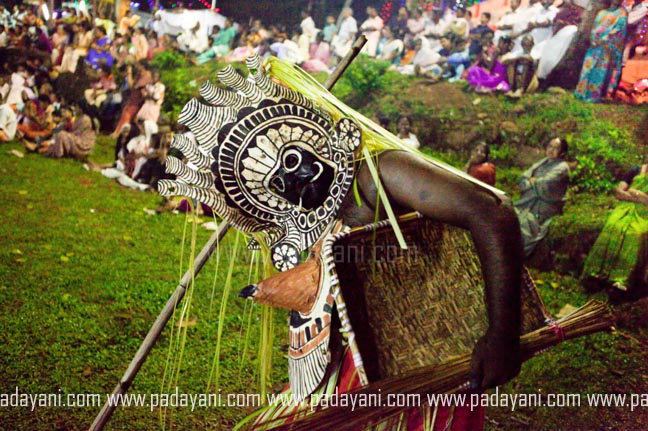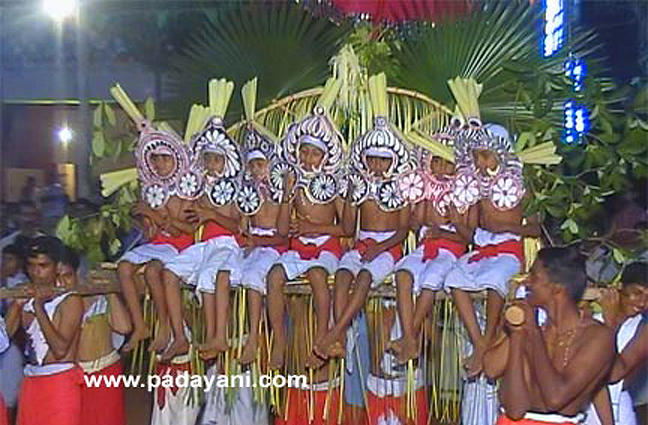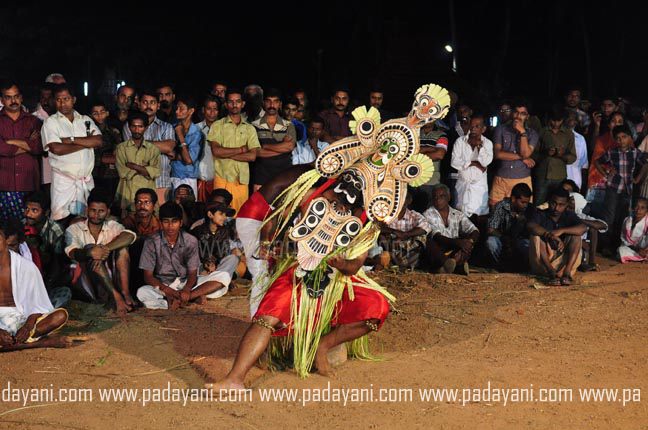Kolam Thullal
Kolamthullal is the most spectacular item that makes Padayani an ecstatic experience. To pacify Kaali to get rid Kavilamma of the ill effects of wicked deities such as Pishachu, Madan, marutha, Yakshi etc. and thus to protect the folk people from calamities, persons disguised as these spiritual forces (Kolam) should perform dances in tune with kolappattu and thappumelam.
Kolappattu (Songs)
Kolappattu are prayers to various folk deities. They include requests, admirations, prayers etc. of folk people who led an eco-friendly agrarian life. In Padayani there are several songs for each kolam. Having the depth of an ocean and the loftiness of a mountain, kolappattu enjoy a unique status. Perhaps, a close analytical study of there songs may reveal several valuable hints on the evolution of malayalam language
Kolamthullal is performed in the light of burning choottu (Dry coconut leaf lets made in to a bundle). Both Kavilamma and the villagers may be possessed by some wicked deities. Kolams of such deities are painted on Areca leaf sheath. Holding these kolam as facemask, artist performs dances with specific leg movements and footsteps.
Towards the end, it is supposed the deity shows its presence and becomes one with the performer. The atmosphere becomes tense, colourful and noisy with arppuvili, ‘kathinavedi’ and vay kurava. The deity takes quick and rhythmic strides. In a few minutes everything attain a pacified mood. Now it is decided, Kavilamma and villagers are safeguarded from the ill effects of wicked deities. Actually structure of kolam, rhythmic foot strides, leg movements and melodious singing are the factors those make Kolamthullal both tense and beautiful.
Each kolam reaches the Kalam (stage) after performing certain customary steps of worship such as Ganapathy and Padivattom. Each kolam has its own dressing and adorning style. Tender coconut leaves, Charcol paste, manayola (a mineral) silks etc. are the main materials used for kolam preparation in general. Foot steps employed in kolamthullal are Otta(single), Iratta( double) mukkanni and valyamukkanni. Performers take various ‘Kalayams’ such as Ottakalayam, Chadikkalayam, Murikkalayam , panthakkalayam etc.
Different types of Kolam
Vellayum Kariyum
Face of the artist painted half white and the other black. Painting directly on the face is considered to be the oldest way of kolam creation. The system of painting kolam on Areca leaf sheath came in to existence later. Vellayum Kariyum symbolically represents the concept 'from darkness to light' or 'from wickedness to goodness'. This kolam performs Ganapathi and Padivattom on the four sides of the temple and also at padayanikkalam. No other dance seen performed by this kolam. No evidence is available regarding the evolution of this kolam. Vellayum kariyum is staged at Kurampala alone and not elsewhere.
Ganapathikolam
This kolam is rarely staged. It is also known as sivakolam. Areca leaf sheath is made with Nagappathy(Serpent head). Below this there are rounded lines towards the bottom. Face is painted green. Skirt made of tender leaves of coconut worn above red silk. There will be chilampu on the legs. Kolappattu describing the birth of lord Ganapathi is sung in a fast rhythm. Nagappathy on the cap reminds the concept of Lord Shiva. Now a days Ganapathi Pishachu kolam is mistakenly staged at different places as Ganapathikolam.
Ganapathi Pishachu Kolam
Though in the name there is Ganapathi, this kolam is not at all related to Lord Ganapathi. In the song it is addressed as Pepishachu who came forth to make goddess Parvathy, (wife of Shiva), get rid of the influence of wicked elements. Face mask is cut taken from a single areca leaf sheath. Top of the mask resembles Thrisul. This kolam might have got its name ganapathi Pishachu as it comes first in the kolam performance. Wearing coconut tender leaf skirt above silk one, holding lighted torch (Choottukatta) in both hands kolam performs dances. Song of slow rhythm in adantha thalam and that of fast rhythm in muri adantha thalam are sung while staging this kolam. This kolam reflects, as it seems, some black magic rituals performed by ancient society to safeguard themselves from the wicked effects of Bhootha Prethathi elements.
Kuthira Thullal
This is neither supported by deity concept nor by customary rituals. In some places this is known as Kuthirakkolam. (Preparation of Kuthirakkolam is described under this topic kolamezhuthu). Already prepared horse model is fixed to the waist of the artist. Strings tied to the both ends of the horse model are passed over to the shoulders of the artist and firmly held by the left hand to keep it in position. In the right hand there will be a whip to rear the horse. Hair is covered with white cloth like ‘Arabs’. There will be artificial moustache and beard. Along with kuthirakkolam there will be ‘Pattani’ (Muslim Merchant) dressed people with whip and cloth bag in hands appear in the kalam. Kuthirathullal hints on the ancient trade relation of Kerala with the Arabs. Kolappattu describes the travelogue of merchants going to purchase war horses from Arab countries for Cheraman Perumal (oldest emperor in Kerala).
Marutha Kolam

Mother goddess marutha is worshipped as deity of small pox. Marutha concept varies as Easanthan Marutha, Neelakeshy Marutha, Pandara Marutha, Pacha Marutha, Anamarutha etc. Marutha kolam is staged to eradicate small pox. Anger of marutha causes a number of physical disasters like incurable white discharge, high body temperature, aversion to eatables, unbearable thirsts, swelling on body parts in addition to smallpox. Kaali killed Darika,Darika’s wife Manodari sow seeds of smallpox on Kaali as a revenge. Manodary was later transformed to Marutha.
The performer reaches the kalam with kolam wearing leafy twigs of Ilanji tree ( at the waist and holding rod, broom, Muram and knife in hand. After Ganapathy and padivattom, Chat commence. It includes various domestic activities like sweeping the premises, combing hair, drying rice, heaping rice, grinding rice in grindstones etc. In the end taking some broken rice in hand, plans to put it in mouth. But just before doing this the kolam pauses a little as if it remembers some other thing. The broken rice is thrown round in all the four directions one hand full to each. Taking the fifth handful rice, Marutha produces an unmanly utterance. Hearing this plenty of maruthas including child marutha (pilla marutha) come forward to the kolam producing horrible sounds. Different strides namely otta, Iratty, Mukkanni, Valyamukkanni, Kothukal, Porukal, Thettineekkam are employed in maruthakkolam. Songs are in ‘Adantha’ slow, ‘adantha’ and ‘muri adantha’ style.
Madan Kolam
Madan is a wicked god who can kill a person just hitting on his shadow. Vadimadan, Thoppimadan, Chetta Madan, Pullimadan, Kalamadan etc. include in the Madan list. Madan kolams are staged indifferent days. It is further believed that Madan is the protector god of cattle. On the forehead of the Madan kolam a third eye is also generally painted. Top end of the kolam is cut made to the shape of Shivamudi. Chest shield and poonool (holly thread) are also painted for the kolams. Kalamadan is the supreme commander of Kaalam (time). Vadimadan holding a stick in hand, performs vigourous dance looking at the sky. At intervals fearfully hitting ground with the stick, Vadimadan makes loud horrible sound. There will be painted dots (pully) on Pullimadan kolam. Thoppimadan bears a hat made of Areca leaf sheath. Chettamadan kolam is fully painted on leaf sheath and is fixed stitching on a woven coconut leaf frame. Holding this huge structure, the performer take rhythmic steps.
Yekshi Kolam
Variety of Yakshi kolams are staged in Padayani. Each Yekshi kolam has its own specialiteis and characterstics in features, expressions and also in performance. Common people consider Yekshi as frightening supernatural element with wild features. Apart from this concept in padayani, Yekshi is worshipped as embodiment of beauty. Yekshi is a true kin to man. She safeguards him from calamities.
Sundara Yekshi
Face mask cut made from a Single Areca leaf sheath, Nenchu mala (Chest shield)., colourful silk at the waist, above that skirt made of tender coconut leaves, areca inflorescence in hands, tender leaves of coconut palm on fingers- these are the features of Sundara Yakshi kolam. Team of at least four kolam should perform dances at a time. This number can be raised to six or eight. After Ganapathy and padivattom kolam performs ‘ Nirathithullal’. General strides are Chittadi, otta, Iratty, Mukkanni, Valyamukkanni, Vettiyettam, Chavittyirakkam and vattachuvadu. ‘Thalams’ employed are ‘marmathalam, Adantha slow, Adantha otta and muri adantha. The song addresess deities of beauty who can compete with and defeat the supreme beauty queens. It is persumed that deities of beauties come to the kalam and present their magic dance and finally vacate themselves.
Anthara Yekshi
This is a crown shaped kolam. To keep the kolam in position a string embedded within the kolam is tied fast the chin of the performer. At last nine areca leaf sheaths are required for the preparation of crown, Chest shield (nenchu mala) waist shield etc. of Antharayakshi. Bangles and nails of tender coconut leaves are there on both hands of this kolam. Tender leaf skirt at the waist and kachamani on legs are other features. Face is painted with Manayola, Chayilyam(green color) or Charcol paste. Artificial protruded teeth is fixed and then presented to the kalam after Ganapathy and padivattom, performer takes Porukal steps. Then commences song in Chattadantha style.
Ambara Yekshi

In features Ambarayekshi resembles Antharayekshi. Ambarayekshi performs Ganapathy and padivattom standing on a wooden frame with a cloth ceiling. As this Chattom (frame) moves forward, yekshi assumes the style of a flying goddess. Finishing Ganapathy and padivattom Yakshi comes down to the ground and begins to perform dance. Foot strides, movements of hand and body etc. remind the viewers of a plight in the sky. Ambarayekshi performed at Kunnamthanam padayani.
Arakki Yekshi
It has a frightening appearance. This kolam has been disappeared from almost all padayani stages. Mode of dancing of this kolam differs much from that of other and at the same time more interesting than many others. From the kolam mask, face round is cut off. Eyes are artificially painted, protruded teeth are fixed, silk skirt and tender leaf skirt worn one above the other at the waist. Kachamany worn on the legs the kolam reaches the kalam. Strides of Ganapathy and padivattom are taken behind a curtain After that the kolam performs Adavu which are five in number After each Adavu there will be kalayam. At this time the curtain raised once and again covers the kolam. After the Adavu there will be Porukal and then song of Muriadantha style.
Erinaga Yekshi
Though there are songs on Erinagayekshi, Karinagayekshi, Paranagayekshi, Ayaliyekshi etc. kolam dances of such items except those of Erinagayekshi and Ayaliyekshi have become extinct or very rare
Mayekshi
Though this is a crown like kolam mode of assembling varies much from that of antharayekshi. like antharayekshi there will be chest shield, waist shield, tender leaf skirt and kalchilambu in this kolam. kannumkuriyum protruded teeth etc. make it different from the former one. Charcoal is painted on the face. In the hands there will be sword and lighted torch (pantham). Mayekshi is regarded both as the deity of destruction and that of prosperity.
Kalayekshi.
Kolam cut made from fifty one Areca leaf sheath for Kalayekshi is a fearful sight. Kalayekshi wear silk skirt and tender coconut leaf skirt one above the other. A Pantham (lighted torch) is inserted on the main face of the kolam. The practice of performing dance on burning cinders is also seen at some places.
Pakshikkolam
A certain type of bird sitting on trees near to houses with new born babies utter a special sound ‘Kunje... Kunje....’(oh! Baby oh! Baby). Owing to the ill effects of this bird, the child looses its general health and often subjected to diseases. With anaemic appearance, shapeless buttocks, inflated stomach the baby takes last breath very soon. The Villagers generally try to drive away this deadly creature. But a complete revival from the ill effects of the bird is made possible only by satisfying it through necessary sacrificed offerings. Pakshikkolam is staged for this purpose. At the mouth of the kolam beak made of areca sheath is fixed, Nenchumala, Aramala, red silk skirt, tender coconut leaf are there as in other kolams. Coconut tender leaf, removing bony leaf vein (eerkil) is placed as such on the back of the kolam and is held by both hands on eitherside Pakshi reaches the kalam with porukal movements. story of employing a bird by ‘Kamsa’ to attack ‘Sreekrishna’ is sung for Pakshikkolam.
Kalan Kolam
Kalan Kolam enjoys kingly status in Padayani. Only a master artist can perform Kalankolam. Crown shaped kolam has three or five faces. Charcoal paste on the face, Kannum kuriyum, protruded teeth, Tender leaf skirt over red silk skirt, Kachamani on legs. cascade of hair covering the backside, sword in the left hand’ are the features of this kolam. A long cloth fastly tied to Alaku (dry areca tree pieces ,Base frame of kolam) is drawn through armpits of performer tied behind him. This arrangement is to keep the kolam in right position.

A number of strides such as otta, iratti, mukkanni, valyamukkanni, thettineekkam, vettimattom, chavittiyirakkam, chavittikkalayam, kothukal, porukal; kalayams such as Ottakalayam, Irattikkalayam, Murikkalayam, Chadikkalayam, Odikkalayam, Panthakkalayam etc. and nottams such as Nilanottam, Kutharinottam etc. are employed in kalankolam. ‘Markandeyacharitham’ is the theme of kolappattu sung for Kalankolam. In certain places sung Ajamilamoksham and Sivamahathmyam are sung. Another Character controls these kolam and forcefully takeout sword and torch from the hands of kolam artist. though this character has no adornments or special decorations, he attracts the attention of ierr because of his physical strength and artistic awareness. Thullal adverse through Slokas and songs in Thom thiminthaka Thalam and adantha single style. In the cause of dance the kolam is made forcibly seated on an ural (grindstone placed in the kalam) places in the kolam. The thullal artist, at certain other occasions jumps directly backward and climbs the Ural and there he takes several foot steps.
Bhairavi, Ninabhairavi, Kanjiramala
Bhairavikolam is made of 101 Areca leaf sheaths. It is the true depiction of the fearful form of Bhadrakali after killing Darika. Bearing the kolam on the head, wearing Kurutholapavada (coconut tender leaf skirt) over red silk Bhairavi appears in the kalam Bhairavikkolam is otherwise called Mangalakkolam. This kolam comes to Kalam towards day break, after the retrieval of all other kolams. Bhairavikkolam seeks pardon for the faults and foibles that might have occurred in kolam performances during Padayani days.
Kanjiramala is like Bhairavi except for a few differences. Kolam for Kanjiramala is made from 81 Areca sheaths. In Bhairavi elephants and lion are painted on the ear. But in Kanjiramala serpent and flowers are drawn in their place. As both the hands of the artist used for holding the kolam, it is hardly, possible to make hand-body movements.


